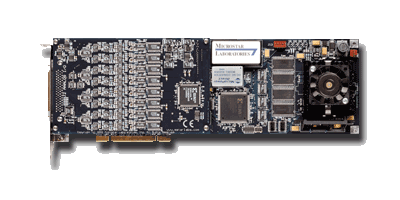
When Do You Need DAP Technology?
|
|
|
|
|
|
|
|
|
|
|
If your requirements are not so simple, you have come to the right place.
|
Point to topics on the right to see why you should consider Data Acquisition Processor boards for your next measurement project. 
|
Do you need high quality measurements?
DAPs can provide direct measurements with 12 to 14 accurate bits, up to 15+ accurate bits in the best case. Accurate bits is not the same thing as hardware converter bits! You can depend on accurate bits to produce accurate measurements for quiet signals, or unbiased measurements for noisy signals. DAP onboard filtering and careful calibration can yield measurement accuracy even in the presence of random noise.
Do you need many signal channels?
If you need 64 channels, 500 channels – or more! – you need equipment like Data Acquisition Processor boards: designed with high-channel-count applications in mind, supported by an array of termination and expansion products. Arrays of little acquisition cards with just a few channels each can quickly turn into a configuration nightmare, whereas one DAP might be all you need.
Do you need high sampling rates?
Data Acquisition Processors are built for speed. At the low, slow end of the DAP product line, sampling rates are 800,000 samples per second – and you do not sacrifice sampling accuracy at these speeds. Some other data acquisition cards sample fast, but not many can maintain accuracy at their maximum rates.
Do you need signal generation?
In addition to sampling, Data Acquisition Processors can also generate signals: complex waveforms, digital alarm outputs, and digital or analog control commands. These processes do not interfere with sampling or reduce its capacity. Output clocking accuracy is the same as the input clocking accuracy.
Do you need simultaneous or almost simultaneous samples?
The timing of samples on different channels can matter a lot when trying to accurately determine phase shifts or time delays. Data Acquisition Processors offer multiple solutions.
- Sample at higher speeds, then decimate away the extra samples you don't need. Not truly simultaneous, but maybe close enough.
- Apply DSP processing on-board to correct for time shifts.
- Use a DAP having multiple converter channels for simultaneous sampling of a few channels at extreme rates.
- Use accessory boards for simultaneous sampling on a very large numbers of channels at moderate rates.
Do you need assured real time response?
The reserve of processing power necessary for high-speed data transfers also make it possible for a DAP to respond to external events reliably. Delays of 10 milliseconds or much longer are commonplace in a loaded PC workstation. But on a DAP, you can expect updates at 1 millisecond intervals or faster that are never late. Be suspicious about any application that claims to run in "real-time" on a PC host.
Do you need intelligent data selection?
Intelligent data selection is a real chicken-and-egg problem. Until you know the data contain something useful, there is no point in measuring. Until you measure, you have no way to know whether the data are useful. DAPs are fast enough that you don't have to worry. They can analyze enough data to determine whether there is anything worth keeping. If not, DAPs are brilliant at discarding data you don't need. This capability is critically important when data volumes threaten to overload a host system.
Do you need intensive filtering or other pre-processing?
A PC workstation has a difficult challenge just to keep pace with its operating system and graphical displays. Add to that numerical processing for hundreds of thousands of numbers on multiple channels, and look out. Using DAP processing as an additional resource, ordinary data selection, filtering, and transforms can be applied in advance. The host receives just the finished information it needs, leaving it more time for the higher-level processing.
Do you need flexibility for unexpected requirement changes?
For a system ready to go into production, you (should!) have complete understanding of all design constraints. You can select an acquisition device that does just what you need and no more, for best economy. But for a new development project, it is rare that you will have total design knowledge in advance. Simple and cheap data acquisition products have limitations that you will encounter quickly; you will have to push much harder to reach the limitations of Data Acquisition Processors.
Do you need reliable long term operation?
DAP processing has no unplanned interruptions, no conflicting applications, no monitors or daemon processes to interfere. Keep the power on, and a Data Acquisition Processor continues to run. DAP processing is reliable because it is easy to enforce the following restrictions.
- Your application is the only one running.
- Run only data acquisition processes and data transfers.
- No user inputs such as keyboards or pointing devices.
- No processing changes until you deliberately shut it down.
Now, try living with those same restrictions on your host workstation.
© 1994-2025, Microstar Laboratories, Inc. All Rights Reserved.
webmaster@mstarlabs.com 888-678-2752 (US/Canada) or +1-425-453-2345